---------------------------------------------------------------
Åsmund Gamlesæter & Alexander Berman
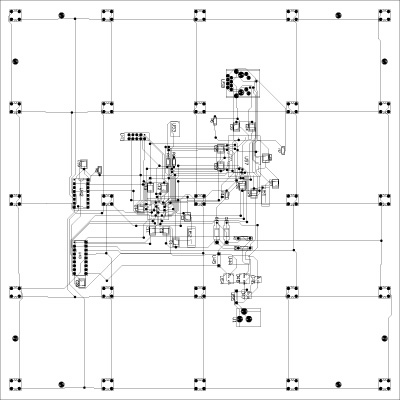
Living Wall
The artwork begins with a question: what would happen if the surfaces that surrounds us were given memory and an identity. Living Wall has sound and image sensors recording fragments of human interaction that it finds interesting. Each new recorded fragment is analysed using voice recognition, determining its relation to previously stored clips. If the wall becomes bored, it intervenes by displaying sequences of the recorded clips on LEDs integrated in its surface. The sequences are recomposed by the machine itself in an attempt to mimick the behaviour of how we associate ideas.
The artwork is a permanent installation at Studentersamfundet, made specifically for UKA-05. It was produced in the studios of PROJEKT0047
in Berlin. The technological development and physical production was done in Trondheim with help from the Computer Science department of NTNU. Students Olav Gulling and Terje Øfsdahl worked full-time during the summer implementing and developing software and hardware alongside the artists. The installation would never have happened without the help from IDI - NTNU, Farnell, Alphatron, Technoport, Atmel, Finn Magnus Rasmussen at TreStykker and many more. Thanks to all of you.
---------------------------------------------------------------
Thorbjørn Lausten
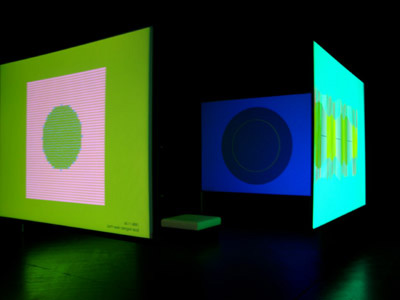
Pictures from afar - scientific Visualization
Presentation of a number of works dealing with visualization of scientific data, mostly satellite data, in connextion with the use of electronic communications technology in an art, science technology context.
In making works and in the presentation of works the work not is to be considered a material work but rather a structure which is definend as a system of relations, and in doing so you indicate one or more methods to be applied in dealing with artistic as well as scientific images.
Energy and information have changed our understanding of reality in focusing less on matter than on how systems interact and how they may depend on each other. The understanding of such dependen-cies and complexities can best be understood as constructions be they artistic, scientific or formal logical, and you consequently focus on how to come to an understanding of the functional modi that
constitute such constructions.
In the presentation of the works we will deal with visualization as representation and the often complicated relationship between art and technology. To act of thinking and the use of technology can often not be separated, and reference will be made to our conceptions of nature, which is changing as a result of our technological/scientific constructions.
---------------------------------------------------------------
Adam Somlai-Fischer
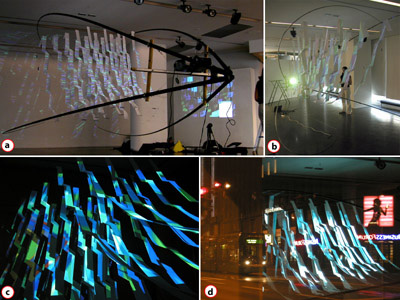
Ping Genius Loci – aether architecture
Most technological innovations, that have paved the way for new kinds of cultural production, have resulted in explosion-like sociological changes. Dating from the invention of printing, that resulted in the emergence of nation states, to the highly researched contemporary advance of networks that pervade our social spaces, our thinking and our environment.
The interaction between the individual and the communities have undergone major transformations, so have the uses and functions we wish for in our daily interaction with our environment, with our cities.
Therefore it can be argued, that the medium of architecture is changing, the substance that used to shelter, than to communicate cultural identity, could easy disperse to communicate among all of us participating in the society, open up its domain for the networks of our dissolved identities.
Aether architecture is developing design research projects, that aim to allow the medium of architecture to participate in this network, to allow to be addressed, and to allow it to respond, to open it up for the large number of communal interaction possibilities. Since sustainability still stays as an important factor, we research phenomena with low inertia, that is perceivable parts of our reality and does not take too much energy to be altered, and so, to be informed with change.
Our projects also take physical presence as an important factor, as our built reality does have a strong reassuring identity against the flow of change. To breed this two, has been the focus of these explorations. Since these experiences are new, we did not choose to explore them in drawings and renderings, rather are focusing on building prototypes that function and give a more real experience that we can learn from and build upon.

----------------------------------------------------------------
Hege Tapio
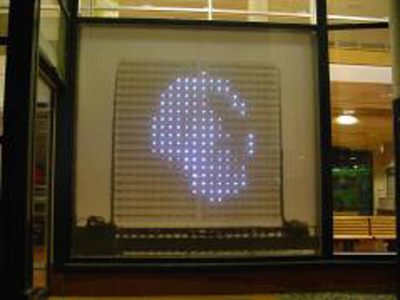
Biosensor
Integrated into one of the windows of the Stavanger City Terminal's window section facing the Breia Lake, is the pulsating public art work BIOSENSOR, a handmade 3x3 m light display. Artist Hege Tapio, in collaboration with fellow artist Jens Laland, has brought to life the work BIOSENSOR, which title is taken from a biotechnological measuring device for finding traces of explosives, narcotics or bacteria.
The light display consists of 800 LEDs that make up a dual sided screen. Laland has built the electronic control system and developed a technical solution for controlling the animations on the display. A sensor registers people passing the entrance of the City Terminal, and initiates an animation loop on the display. More than a dozen different animations are chosen in random order and shown 24 hours a day. When nobody is passing through the entrance, or the building is closed, a resting pulse is shown - an animation resembling a pulsating heart.
All the animations are based on video clips from nature. Standing by the music pavilion in the park looking towards the City Terminal, you may see a flower opening, an eye looking, an animal running, cells growing, a drop falling and other more abstracted expressions.
The underlying artistic idea can be explained like this: The City Terminal, like all such terminals, is not a very comfortable place. People are passing through on their way to something. Some of them have all the time in the world before the next bus or train. A situation that easily takes us on a journey in our own little world -- watch the movements of the art work in the window, let the imagination fly.
The work can be interpreted both as a reminder of the surveillance society and as a contemplative element for travelers in a busy leg of a journey.
----------------------------------------------------------------
Bjørn Wangen
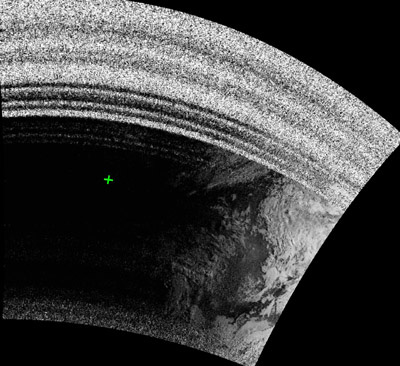
X – I am here: Antenna, radio/computer, looping slideshowprojection and sound.
This work is about being. If nobody recognises me, the satellite will.
This work is about being in the world. It is about landscape imagery, like the old romantic point of view; being in the landscape, or looking at the landscape. A simple cross points out my position. I am in the world. If nobody recognises me, the satellite will.
The antenna fetches weather report images fram passing satellites. The images are projected in a slideshow loop in a pulsating fashion. Old images are replaced by new ones as new satellites passes in the sky.
----------------------------------------------------------------
Thomas Kvam
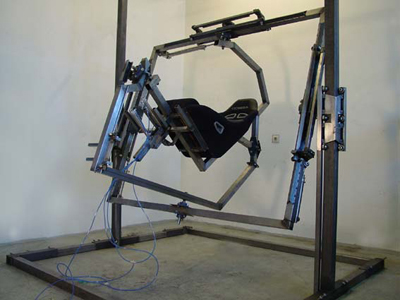
Thomas Kvam/ Frode Oldereid: "The Dream Machine" prototype.
"The Dream Machine" is a realisation of the idea from the 1920ies of the total cinematic experience, where one thought that all human perseption could be simulated through machines. "DreamMachine" is a simulator constructed for total control and manipulation of human perseption.
er en realisering av ideen fra 1920 tallet om den totale cinematiske erfaring, hvor man forestillte seg at all mennesklig persepsjon kunne simuleres ved hjelp av maskiner. "DreamMachine" er en simulator konstruert for total kontroll og manipulasjon av mennesklig persepsjon.
----------------------------------------------------------------
Frank Fietzek
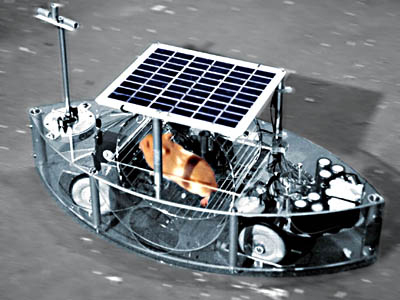
Frank Fietzek was born in Kiel, Germany, in 1960. Living in Berlin, he is a media artist and has been working as a project director at the Labor für elektronische Medien (LEM) in Hamburg and as a resident professor in Stuttgart, Hamburg, Weimar, and Berlin. Since 1983 his work has been shown in numerous personal and group exhibitions including "MultiMediale 3", ZKM Karlsruhe 1993; "Minima Media", Medienbiennale Leipzig 1994; "Today - tomorrow", Marseille, Frankreich and Osaka, Japan 1998/99, "Im Buchstabenfeld," neue galerie graz 2001; "P0es1s", Kulturforum Potsdamer Platz, Berlin 2004. Fietzek has received several grants and awards (amoung others "Ars Electronica" - Honorable Mention 1999, 2001 and a grant from the senate of Berlin, 2004)
----------------------------------------------------------------
Uli Winters
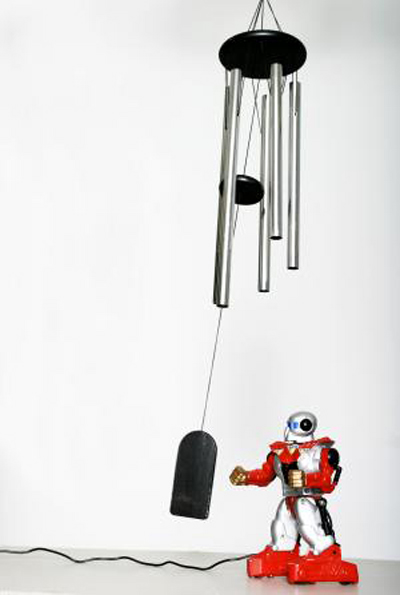
Uli Winters (born 1965), passed his studies of Fine Arts at „Hochschule für Bildende Künste“ in Hamburg with distinction in 1999. He has been taking part in various personal- and group-exhibitions in Germany, Austria, Netherlands, France, and USA. Besides the conception and production of his mechanic and electronic artpieces („Schamanomatics“) he is involved in a lot of other activities like writing columns and articles for magazines, developing cartoon-series, writing song lyrics, writing and performing for theatres and managing a company for interactive advertising. He lives in Hamburg and on the dark side of the moon.
Most recent Works:
„Wo ist eigentlich der Schlüssel?“ March 2005
(„Where is the key after all?“) A poetic evening in the „Schaubühne Leipzig“ with various Poets, a choir, actors, speakers and talking puppets. Concept and directing: Michael Lentz and Uli Winters. Funded and presented by „Kulturstiftung des Bundes“ („Federal Foundation for Culture“)
„Literaturhaus-Tour“ March 2005
A series of performances in Venues of Literature throughout Germany (8 Cities). Michael Lentz (Poet) including talking puppets and prosodic experiments.
„Wulst“ April-August 2005
A lecture at the college of fine Arts, Hamburg
„Kunstmaand Ameland“ December 2004
International Exhibition on the Island Ameland, Netherlands
----------------------------------------------------------------
Usman Haque
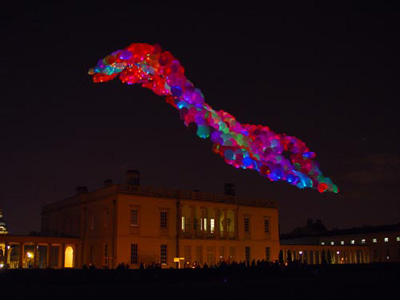
Surrounding architecture
Consider architecture as something impermanent: how can one design for the ephemeral, knowing that the ephemeral is at every stage just beyond reach? This talk will outline a creative research approach that is informed by architectural practice through discussion of actual built projects.
Projects to discussed include:
1000 (little tips of communication) - a system for technologically--ware bodies in technologically-animated spaces that challenges conventional ubiquitous computing approaches. [With 5050 ltd].
Low Tech - prototype research for a suite of low-tech sensors and interactive actuators that can be produced inexpensively from hacked toys and devices. [With Aether Architecture].
Haunt - using humidity, temperatures and electromagnetic and sonic frequencies that parapsychologists have associated with haunted spaces to build an environment that feels "haunted".
Sky Ear - a floating glowing cloud, embedded with mobile phones, listens out for electromagnetic waves in the sky.
Open Source Architecture Experiment - architecture as an 'operating system' enables people to create architectural 'programs'. This experiment in collaboration explores how such a system benefits from open source tactics.
Scents of Space - an interactive smell system that allows for three-dimensional placement of fragrances without dispersion
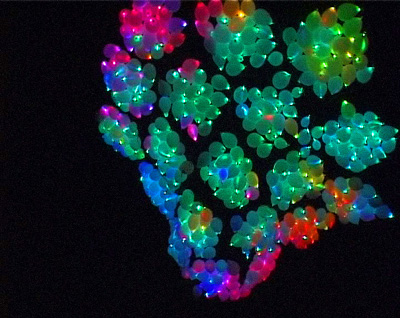
foto: David Rothschild Photography
----------------------------------------------------------------
Gediminas & Nomeda Urbinas
----------------------------------------------------------------
Tale Næss
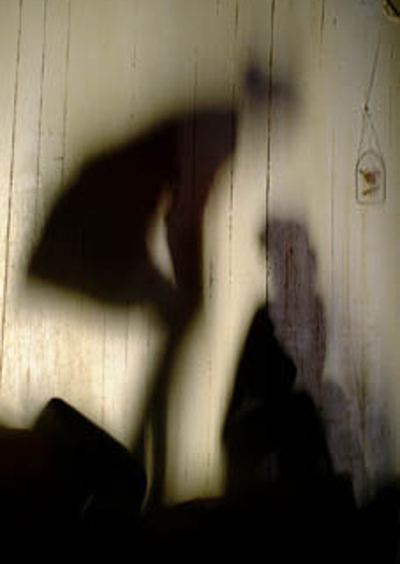
From the play "Relics"
Working with the performative aspects of the text Tale Næss has developed a fascination for the human voice. This has resulted in a series of works, sometimes in collaboration with other artists from a variety of fields, sometimes solo projects. Some of these work has been shown in a gallery situation, other has been shown in connection with dramatical or theatrical events.
Latest works:
“She is this” – a sound installation for one voice – shown in galleries in Denmark, Poland and Norway.
“Relics” – a dramatic installation involving surround sound, scenography and live action. The performance was made in collaboration with Kirsten Delholm (Hotel Proforma) and the Visual artist Vibeke Steinsholm.
“Lets pretend that you are a bird” – a sound installation for one childs voice and a ultrasoundspeaker – shown at a gallery situation but at the Propellen Theatre Festival.
“Let’s take a walk” – a dramatic installation for two male voices and a simple scenography – shown at Stamsund International Theatre Festival 2005.
Næss is currently working with the visual artist and animator Erle Stenberg on a project designed for the internet. It’s an expressive collage of voices and sounds, darkness and light, stillness and movement. The work is a part of the PNEK instigated Digital Stories project - a project to promote and distribute technological and digitally based art.
----------------------------------------------------------------
Martin Rieser
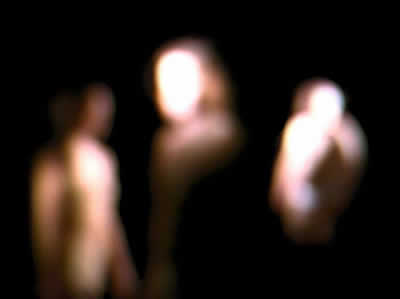
Hosts
Vertical [portrait] screens are placed at strategic opposite points of the space. A visitor triggers the presence of a variety of unfocused and evanescent video characters through the use of movement detection devices and interpretative software. Individual characters appear at random and smile, beckon or otherwise indicate that the visitor[s] should follow them and pass onwards from screen to screen, keeping pace with the visitor[s]. These hosts will be of a wide range of ages, gender, social types and races, drawn from the area, but will always appear singly.
Thematic
The piece is a reflection on human life and death, presence and absence. The hosts may be taken to represent a variety of presences: from the angels of Jacobs Ladder, the ghosts of people who have inhabited the same spaces, or fragments of the individual psyche. The emotional mood is deliberately variable and the encounters will change depending on a randomised selection sequence for the video sprite characters and sounds.
Technology
The project will utilise the tracking software to detect human presence and its duration in allocated space zones, corresponding to the screen areas. Information passed to a control computer, which co-ordinates the video feed to individual projectors from a second networked machine. The presences were filmed on high definition digital video and transferred as QuickTime files to a server hard drive.
Further Phases
GPS enabled PDAs and 3g location polling will be used to map the video sprites on to a large area of Bath. They will emerge on screen and speak at concealed locations, following participants around the city. A website will enable further aphorisms to be submitted by the public and mapped to locations. Collaboration with the Mixed Reality Lab in Nottingham and Mobile Bristol is anticipated for this phase of the project.
-----------------------------------------------------------------
Øyvind Brandtsegg
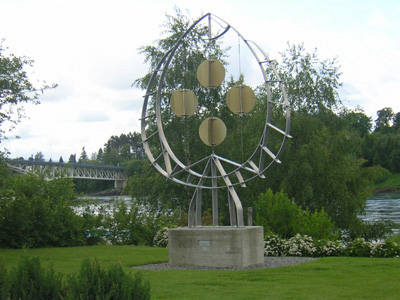
"Flyndra"
The summer of 2006 will see the unveiling of an interactive sound installation in the Muustrø Park at Straumen in Inderøy. The starting point for composer Øyvind Brandtsegg is Nils Aas' sculpture "Flyndra" (The Flounder), to which he will add a musical and sonic expression. The sound installation is constructed so that the metal in the sculpture generates sound, and is thereby completely integrated into the original work. The musical expression of the sculpture will vary continuously, and follow seasonal changes, temperature fluctuations and light conditions. It will also be more active when there is an audience present and, similarly, calm when there is nobody there to actively experience it.
At TMM Øyvind will explain artistic and technical aspects of the installation as well as give a presentation of his ongoing research on compositionally enabled instruments for improvisation.
-----------------------------------------------------------------
Lalya Gaye
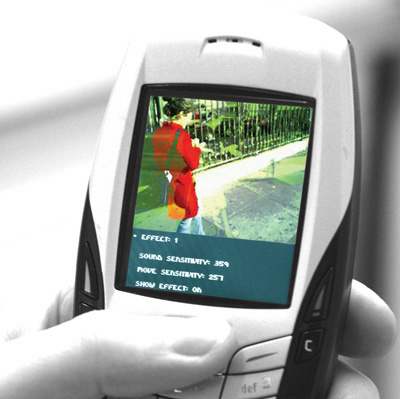
New Technologies and Everyday Creativity
Lalya Gaye is a researcher working in multidisciplinary collaborative projects at the convergence of art, technology and design. In her research, she explores the aesthetic qualities of ubiquitous computing - digital technologies merging with everyday environments and activities.
She is a PhD student at the Future Applications Lab, Viktoria Institute and a member of sound-art and new media collectives in Göteborg, Sweden. She is also a member of the Pervasive and Locative Arts Network (PLAN) and co-organises the workshop series on Mobile Music Technology.
In her talk, Lalya will present some of her work, where she focuses on mobile media for urban space and on computational repurposing of everyday objects. In Sonic City, the urban environment becomes an interface for live electronic music making as you walk through and interact with the city. Picture This! explores new potentials of digital still cameras: context cameras requiring their users to scream in order to get the shots they want; friends engaging in photographic networked performances in their everyday life with BashoCam. In Tejp, audio tags attached on walls whisper to by-passers in public space, and in the performance Tap-n-Bass, the sound of wired-up tap dance shoes is re-mixed in real time into live drum&bass.

-----------------------------------------------------------------
Peter Votava
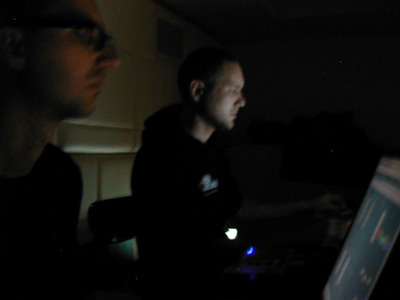
Heart Chamber Orchestra – HCO the living score: a project by Erich Berger and Peter Votava aka Pure.Berger, produced by TEKS in cooperation with the Trondheim Sinfonietta
HCO consists of 12 professional classical musicians - the Trondheim Sinfonietta and the artist duo PURE.BERGER. The musicians and artists are equipped with ECG (Electro Cardio Gram) sensors. A computer monitors and analyzes the state of these 14 hearts in real-time. The acquired information is used to compose a musical score with the aid of computer software. It is a living score dependent on the state of the hearts. While the musicians are playing this score, their heartbeats influence and change the composition and vice versa. The musicians and the electronic composition are linked via the hearts in a circular motion, a feedback. The emerging music evolves entirely during the performance. The music is the expression of this process and of an organism forming itself from the circular interplay of the individual musicians and the machine. Computer graphics, computated from the HCO data establish a different sensual layer. These will be projected on screens behind the Sinfonietta. The interplay of audio and video allows for a synaesthetic experience, so the heartbeats of the musicians become audible and visible.
----------------------------------------------------------------
Tine Bech
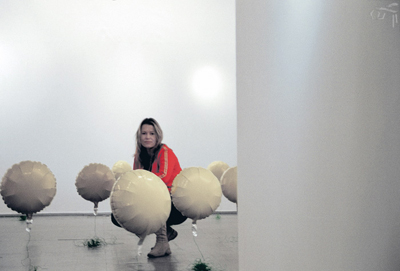
The artist Tine Bech works with sculpture, drawings, installations and sound, exploring the membrane between the body and the world. By using materials that relate to the body, such as tactile materials, interactive technology and sound, her work seeks to trigger an interaction between the artwork and the viewer.
Tine Bech was born in Denmark, but lives and works in London. She has exhibited her work in Denmark, Moscow, Berlin, the USA and England, in venues including The RBS Gallery, L Gallery (Moscow), and Aarhus Kunstbygning and The Fort Collins Museum of Contemporary Art (USA).
She is now showing the installation 'Floating Field' in the "5002" exhibition.
----------------------------------------------------------------